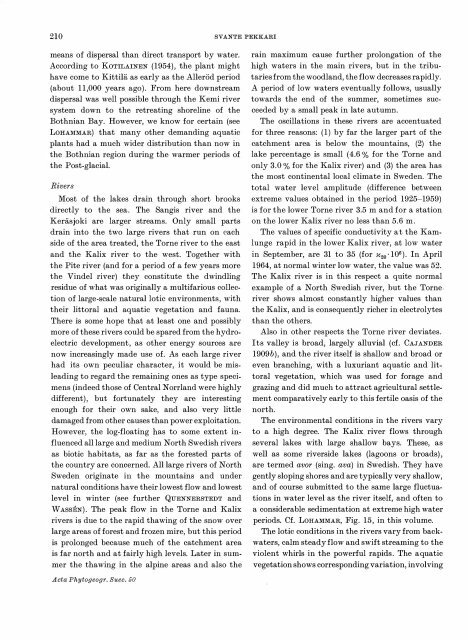You also want an ePaper? Increase the reach of your titles
YUMPU automatically turns print PDFs into web optimized ePapers that Google loves.
210 SV ANTE PEKKARImeans of dispersal than direct transport by water.According to KoTILAINEN (1954), the plant mighthave come to KittiHi as early as the Allerod period(about 11,000 years ago). From here downstreamdispersal was well possible through the Kemi riversystem down to the retreating shoreline of theBothnian Bay. However, we know for certain (seeLoHAMMAR) that many other demanding aquaticplants had a much wider distribution than now inthe Bothnian region during the warmer periods ofthe Post-glacial.RiversMost of the lakes drain through short brooksdirectly to the sea. The Sangis river and theKerasjoki are larger streams. Only small partsdrain into the two large rivers that run on eachside of the area treated, the Torne river to the eastand the Kalix river to the west. Together withthe Pite river (and for a period of a few years morethe Vindel river) they constitute the dwindlingresidue of what was originally a multifarious collectionof large-scale natural lotic environments, withtheir littoral and aquatic vegetation and fauna.There is some hope that at least one and possiblymore of these rivers could be spared from the hydroelectricdevelopment, as other energy s'ources arenow increasingly made use of. As each large riverhad its own peculiar character, it would be misleadingto regard the remaining ones as type specimens(indeed those of Central Norrland were highlydifferent), but fortunately they are interestingenough for their own sake, and also very littledamaged from other causes than power exploitation.However, the log-floating has to some extent influencedall large and medium North Swedish riversas biotic habitats, as far as the forested parts ofthe country are concerned. All large rivers of NorthSweden originate in the mountains and undernatural conditions have their- lowest flow and lowestlevel in winter (see further QuENNERSTEDT andWASSEN). The peak flow in the Torne and Kalixrivers is due to the rapid thawing of the snow overlarge areas of forest and frozen mire, but this periodis prolonged because much of the catchment areais far north and at fairly high levels. Later in summerthe thawing in the alpine areas and also therain maximum cause further prolongation of thehigh waters in the main rivers, but in the tributariesfrom the woodland, the flow decreases rapidly.A period of low waters eventually follows, usuallytowards the end of the summer, sometimes succeededby a small peak in late autumn.The oscillations in these rivers are accentuatedfor three reasons: (1) by far the larger part of thecatchment area is below the mountains, (2) thelake percentage is small (4.6 % for the Torne andonly 3.0 % for the Kalix river) and (3) the area hasthe most continental local climate in Sweden. Thetotal water level amplitude (difference betweenextreme values obtained in the period 1925-1959)is for the lower Torne river 3.5 m and for a stationon the lower Kalix river no less than 5.6 m.The values of specific conductivity at the Kamlungerapid in the lower Kalix river, at low waterin September, are 31 to 35 (for x20·106). In April1964, at normal winter low water, the value was 52.The Kalix river is in this respect a quite normalexample of a North Swedish river, but the Torne.river shows almost constantly higher values thanthe Kalix, and is consequently richer in electrolytesthan the others.Also in other respects the Torne river deviates.Its valley is broad, largely alluvial (cf. CAJANDER1909b), and the river itself is shallow and broad oreven branching, with a luxuriant aquatic and littoralvegetation, which was used for forage andgrazing and did much to attract agricultural settlementcomparatively early to this fertile oasis of thenorth.The environmental conditions in the rivers varyto a high degree. The Kalix river flows throughseveral lakes with large shallow bays. These, aswell as some riverside lakes (lagoons or broads),are termed avor (sing. ava) in Swedish. They havegently sloping shores and are typically very shallow,and of course submitted to the same large fluctuationsin water level as the river itself, and often toa considerable sedimentation at extreme high waterperiods. Cf. LoHAMMAR, Fig. 15, in this volume.The lotio conditions in the rivers vary from backwaters,calm steady flow and swift streaming to theviolent whirls in the powerful rapids. The aquaticvegetation shows corresponding variation, involvingActa Phytogeogr. Suec. 50
















